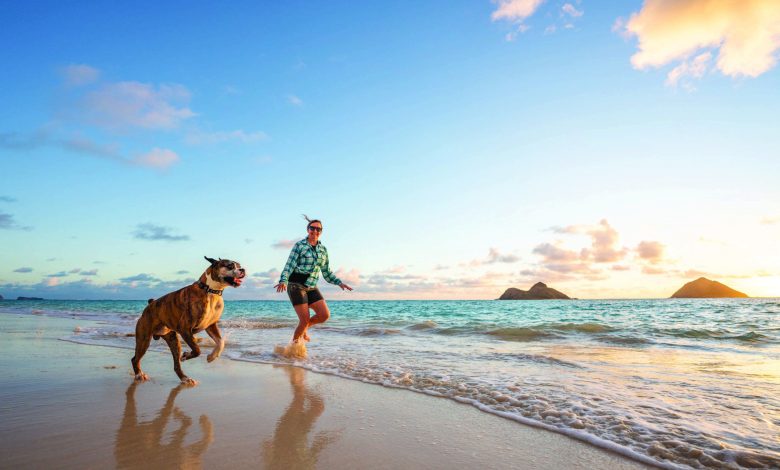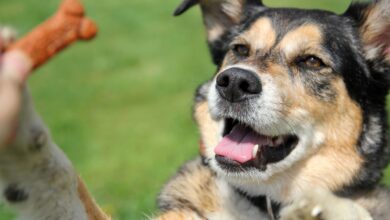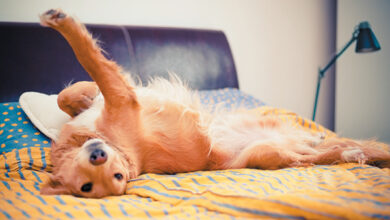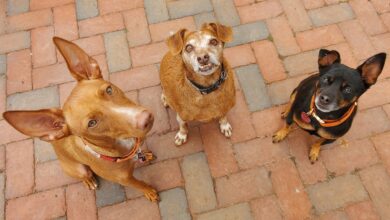Dogster’s Guide to Exercise – Dogster

We know the importance of staying fit, but did you know fitness is also crucial for dogs? A fit dog is less likely to develop joint issues and behavioral problems.
So how do you start your dog on the road to fitness? The answer depends on your dog’s age and current activity level. Here’s how to get your dog going on the path to physical fitness. First, look at his age and current fitness.
Puppy time: If your dog is a puppy — under 1 year of age for small to medium dogs and under 2 years for large breeds — you’ll need to be careful about how he gets his exercise. Puppies are still growing, and their joints are not completely mature, so avoid jarring activities like jumping onto hard surfaces. Competitive sports like agility and obedience should be limited to “flatwork”— that is, negotiating obstacles that don’t involve jumping. You also want to avoid jogging with your puppy for the same reason. The constant jolting on young joints can damage his bones.
Other than these restrictions, puppies can do just about anything else — and they will. Puppies run, roll and play as part of their development. So give your puppy enough time chasing toys and playing with other dogs while he is still young. This will provide him with much of the exercise he needs. If you can offer a lawn, dirt or other surface softer than pavement, it will be better for your pup.

Adult years: If your dog is a full-grown adult but not yet a senior (past 6 years for large dogs, 8 years for small and medium dogs) and has been a couch potato his whole life, you’ll need to start slow in getting him fit. This is especially crucial if your dog is overweight. Too much activity too quickly will not only increase his likelihood of developing joint issues, it will also put undue strain on other parts of his body.
Fit for seniors: For a dog in his senior years, first have a vet examine your dog before you begin an exercise program. You want to ensure your dog doesn’t have any underlying health conditions before you start working with him. Based on what your vet uncovers during the exam, she can give you advice on how to get started increasing your dog’s exercise.
-
Develop a fitness plan
Before you start increasing your dog’s exercise, come up with a goal. Do you want your dog to lose weight? Are you hoping to make him into a jogging partner? Do you want to go on a long hikes with your dog? Your ultimate goal will help determine the level of fitness you plan to achieve.
Once you know where you are going, develop a plan to get there. If your dog is still a puppy, focus on training as you work on fitness. Most puppies don’t need encouragement to move. But they do need help understanding how to behave on the end of a leash. Once your puppy has had all his shots (usually by around 17 weeks), it’s safe to take him out in public. Go on short 15-minute walks every day as you practice your basic training cues, gradually increasing the amount of time you walk each day by about 10 minutes, per week.

If your dog is an overweight adult or a senior, start with short walks of about 20 minutes each day. Gauge how your dog is doing. If he seems exhausted by the end of the walk — lies down, doesn’t want to continue — back off about 5 minutes and see if this makes a difference. You want your dog to enjoy his exercise, and if you push him too hard, he will learn to hate it. If he handles the 20 minutes every day for a week without issue, increase the amount of exercise time by 10 minutes each day, per week.
For adult dogs who are not overweight and have no health issues, start with 30-minute walks and increase them by 10 minutes a day for a week. If your dog doesn’t seem overly tired, keep increasing the time by 10-minute increments per week.
Even if your goal is to have a jogging partner, start with walking, not running. Your dog needs time to build up his stamina and muscles before you begin to run. If your dog is an adult with no weight or health issues, start jogging with him after at least a month of brisk walking. Keep the jogging short to start with — no more than 10 minutes at first — in the middle of your walk. Gradually increase the amount of jogging you do by 5 minutes each day, per week. Keep an eye on your dog to make sure he doesn’t appear overtired after these sessions.

-
Add variety
As you gradually increase your dog’s exercise, add some variation to the routine. Instead of always walking around your neighborhood, take your dog to a local park. Or drive to a different part of your town and walk on new streets. This not only provides variety for you, but also helps your dog become acclimated to new environments and keeps both of you from getting bored.
-
Check your progress
After 6 weeks on your dog’s exercise program, determine how he is doing. Does he seem to be able to walk or run a little more each week without becoming tired? Does he act excited when it’s time for exercise? Has he developed any physical issues, like a limp or cracked paw pads? This is the time to determine whether your fitness program is helping your dog become more fit or bringing out any health issues that need to be addressed.
If you sense your dog is not becoming more fit but is instead developing problems, make an appointment with your vet for an evaluation. If your dog is enthusiastic and becoming an athlete before your very eyes, continue what you are doing until you have reached your fitness goal. Then stay on a maintenance program that will keep both you and your dog physically fit.

Types of Exercise for Dogs
- Walking
- Running (alongside you or your bike; use proper equipment and train your dog before doing this)
- Hiking
- Swimming
- Playing games like fetch and chase
- Stand up paddleboarding (SUP)
- Surfing
- Dog dancing
- Trick training
- Skateboarding
- Dog sports
- Agility
- Scent work
- Rally
- Fast CAT (coursing ability test)
- Barn hunt
- Herding
- Lure coursing

When to limit or not exercise
As long as your dog is comfortable and has the stamina, there is not a limit to how long you should walk him, but monitor his condition throughout the walk. However, there are times when you should not walk your dog or you should limit walking.
- Don’t exercise your dog outside if it is too hot. Dogs can get heatstroke in temperatures 70 degrees Fahrenheit on up, plus you need to take humidity into consideration. Keep a close eye on brachycephalic dogs and dogs with heavy coats, as they don’t do well in hot weather.
- Don’t walk your dog if it is too cold. Definitely don’t walk your dog if it’s below 0 degrees Fahrenheit outside. Dogs can get hypothermia when tempera-tures are 40 degrees Fahrenheit or colder, depending on the dog’s size, coat and health. If your dog starts to shiver or puts one foot up and then holds another one up, these are signs he’s too cold.
- If you have a brachycephalic dog (flat faced/short nosed dogs like Pugs or French Bulldogs), keep walks limited to under 30 minutes. Their flatter noses make it harder for them to breathe.
- If your dog is a senior or geriatric, keep an eye on his condition during the walk, as older dogs are more sensitive to heat and cold. Also, keep the pace slower and watch for any signs of limping or stiffness.

Source link






